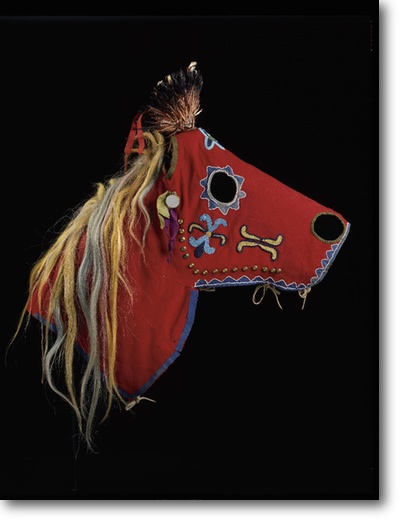
America's First Artists
Art of the American Indians, The Thaw Collection
 Tour North America through the artistic eyes, creative hands and reverent hearts of people who lived on the North American continent from antiquity to modern times, with a concentration of impressive artifacts from the 1800s.
Tour North America through the artistic eyes, creative hands and reverent hearts of people who lived on the North American continent from antiquity to modern times, with a concentration of impressive artifacts from the 1800s.Stout totems, which were created to be used as interior posts in an Indian house, are positioned on both sides of the entrance to the exhibit providing a solemn approach to the display. With ceremonial drumbeats in your ears, you are welcomed by a tall, carved wooden man called a Potlatch Figure, which is named after the traditional festival of the indigenous cultures of the Pacific Northwest Coast. He beckons you forward with a come-hither finger. His stern expression is indicative of the significance of the cultural event for which he was made. Each room in the exhibit showcases the artifacts of one area of the continent.
The Northwest Coast: This first room displays some objects used at the Potlatches, such as amazingly-carved ladles that incorporate elongated animals into their forms. Wooden bowls with swollen walls were made this way to indicate the bounty of the people presenting the feast. These bowls were decorated to suggest an animal on its back, and its' belly is the holding food.
The Arctic and Subarctic: Resourcefulness in a barren landscape is the hallmark of these ingenious people: A parka made from seal gut that was inflated to dry, then cut into strips and sewn together, and finally, made pleasing to the eye and spirit with sewn V-shaped patterns in red, green and purple. The snow's blinding effect on the eyes was dealt with cleverly as well. Goggles carved from walrus ivory have narrow slits in them, allowing the wearer to function and focus in spite of the intense solar rays.
The Southwest: Pottery shards found early in the 20ith century unearthed a very small, unknown culture of indigenous people in the Southwest known as the Mimbres. These people lived in rudimentary buildings and it appears that in all other ways they lived an unsophisticated existence, except the pottery they made. The elegance of their sculptural shapes and the refinement of the painted decoration betray the simple lives of the people who made them. Also remarkable in this room are the Navajo blankets, with their resplendent color and striking graphic patterns.
California and Great Basin: Woven baskets, from delicate hand-held vessels with lids, to broad gambling trays, are the most impressive pieces in this room, intertwining the artistic forms, natural elements and cultural patterns of the people who crafted them into baskets.
Plains, Prairie and Plateau: A Man's War Record is the name of a large Buffalo hide painted with repeated scenes of intricate interactions of horses and men. These drawings are each a little story so precisely drawn, I could have stood all morning examining each little scene in this complicated painting. The delicate lines and clear colors are unexpected on such a crude surface. This entire room is full of exuberant color, especially the brightly-beaded children's ceremonial wear and saddle. The most stunning piece in this room, though, is the Horse Mask (pictured). Now that's a horse of a different color!
Woodlands: Finally, the Indians of the Northeastern woodlands were the first to encounter the Western cultures and to absorb elements of these new people without being absorbed by their culture entirely, in spite of the intense pressure to do so. The patterns in the painted skin clothing and beaded bags display western influences while retaining the skill, attention to detail, and the respect for the materials used that the native people valued.
The exhibit's experience is enriched by the photos accompanying many of the pieces which show articles, like those on display, being worn or used, giving meaning and context to the featured items. Art of the American Indians is open now through May 30 at the Cleveland Museum of Art. Admission is free. http://www.clevelandart.org
 Carol Drummond has been a professional designer for 25 years. Prior to starting her award-winning graphic design studio 15 years ago, Drummond Design, she graduated from the Art Institute of Pittsburgh, worked at a graphic design studio, a video production company, and a consumer products company. She has been an art docent for Mayfield City Schools and currently serves on the COSE Arts Network Advisory Committee. http://www.DrummonDesign.com
Carol Drummond has been a professional designer for 25 years. Prior to starting her award-winning graphic design studio 15 years ago, Drummond Design, she graduated from the Art Institute of Pittsburgh, worked at a graphic design studio, a video production company, and a consumer products company. She has been an art docent for Mayfield City Schools and currently serves on the COSE Arts Network Advisory Committee. http://www.DrummonDesign.com